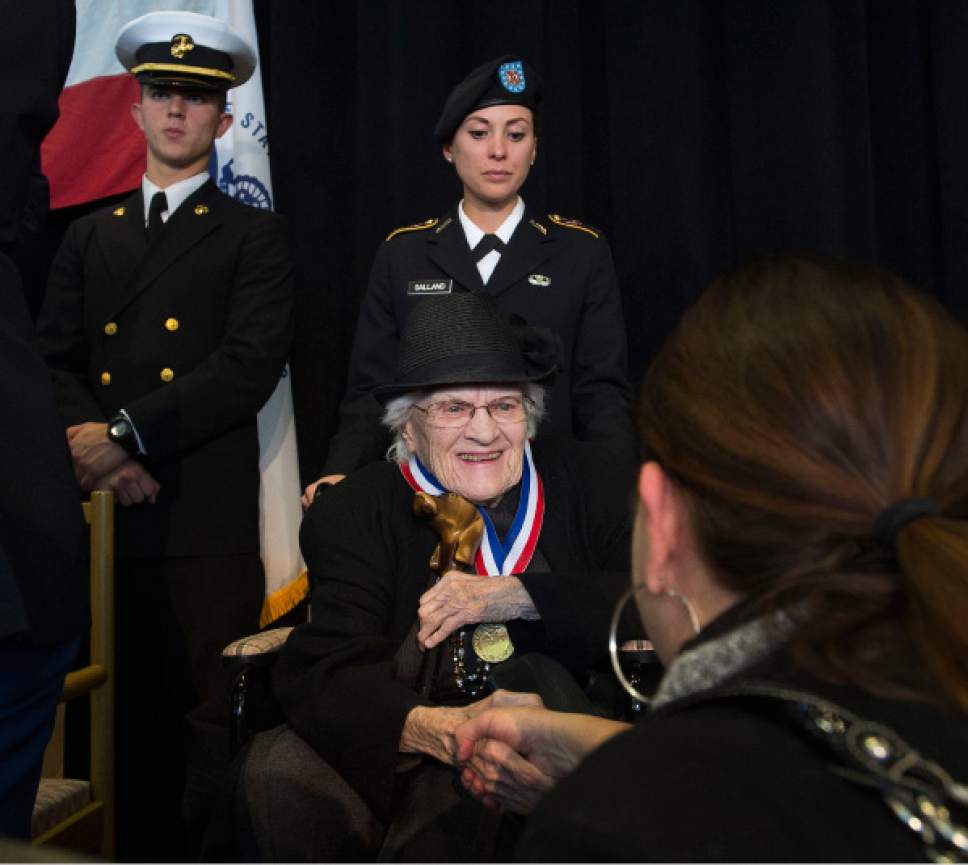This is an archived article that was published on sltrib.com in 2016, and information in the article may be outdated. It is provided only for personal research purposes and may not be reprinted.
As Ward Mayfield walked onto the stage Friday, the master of ceremonies recited Mayfield's Army service record, including how improvised explosive devices blew up around him twice in Iraq in 2007 and four times after he deployed to Afghanistan in 2009.
Mayfield spent two years receiving medical treatment. On Friday, he was one of 11 veterans recognized for his military service during the annual Veterans Day ceremony in the University of Utah's student union.
The honorees spanned World War II to the Iraq and Afghanistan conflicts, but for the younger veterans, wounds were a more-prominent part of their biographies
"We're living through more than we should have," Mayfield, the 32-year-old Taylorsville resident said after the ceremony.
The honorees Friday included Bryant Jacobs, 36, of Herriman, who was the subject of a 2014 Salt Lake Tribune series about choosing to have his leg amputated 10 years after it was shattered by a roadside bomb in Iraq.
Another honoree was Layne Morris, who served with the Utah National Guard's 19th Special Forces Group. In Afghanistan, the enemy threw grenades over a wall into his unit. Morris left his cover to aid the wounded. He then stood to fire a grenade launcher when he felt a blow to the right side of his head.
The blast cost Morris, now the director of the Community Preservation Department for West Valley City, the use of his right eye. On Friday, the emcee read Morris' joke: That he came in second in a grenade-throwing contest.
The generational differences were not lost on Friday's older honorees.
"I wouldn't want to trade places with them," said Richard B. Carter, a B-52 pilot during the Vietnam War, who is now 85 and living in Draper.
The highest-ranking honoree was retired Air Force Gen. Robert C. Oaks, a Vietnam veteran who went on to serve as a Mormon general authority in the LDS Church's Quorum of the Seventy.
Oaks, 80, attributed the difference in combat wounds to the way war has changed. The primary weapon of World War II was a rifle. In Iraq and Afghanistan, it was a roadside bomb.
"It just does different damage," Oaks said.
Oaks and other honorees remained on stage to shake hands with the few hundred people who were in the audience. Joshua Hansen left the stage early.
Hansen, 45, of Woods Cross, was off to the side talking with friends and family. He is still recovering from a brain injury he suffered in Fallujah, Iraq, when he was in the Army, and said the ceremony was a lot of commotion for him.
Hansen started a charity called Continue Mission that works with veterans and tries to prevent their suicides. His father served in Vietnam. The charity serves older veterans, too.
Hansen rejected the idea the different generations of soldiers, sailors and airmen suffered different injuries.
"They all came home with them," Hansen said. "They just weren't recognized like now."
Twitter: @natecarlisle —
Other veterans recognized at Friday's U. ceremony
• Cornelius DeJong, Jr., 91, of Salt Lake City; motor machinist's mate first class U.S. Navy, World War II
• Sidney K. Ingram, 66, of St. George; first lieutenant U.S. Army, Vietnam
• Richard Justeen, 74, of Bryce; captain U.S. Army, Vietnam
• Donna E. Curie Mecham, 98, of Salt Lake City; first lieutenant U.S. Army, World War II
• Donald T. Sellers, 70, of North Ogden; sergeant U.S. Marine Corps, Vietnam















